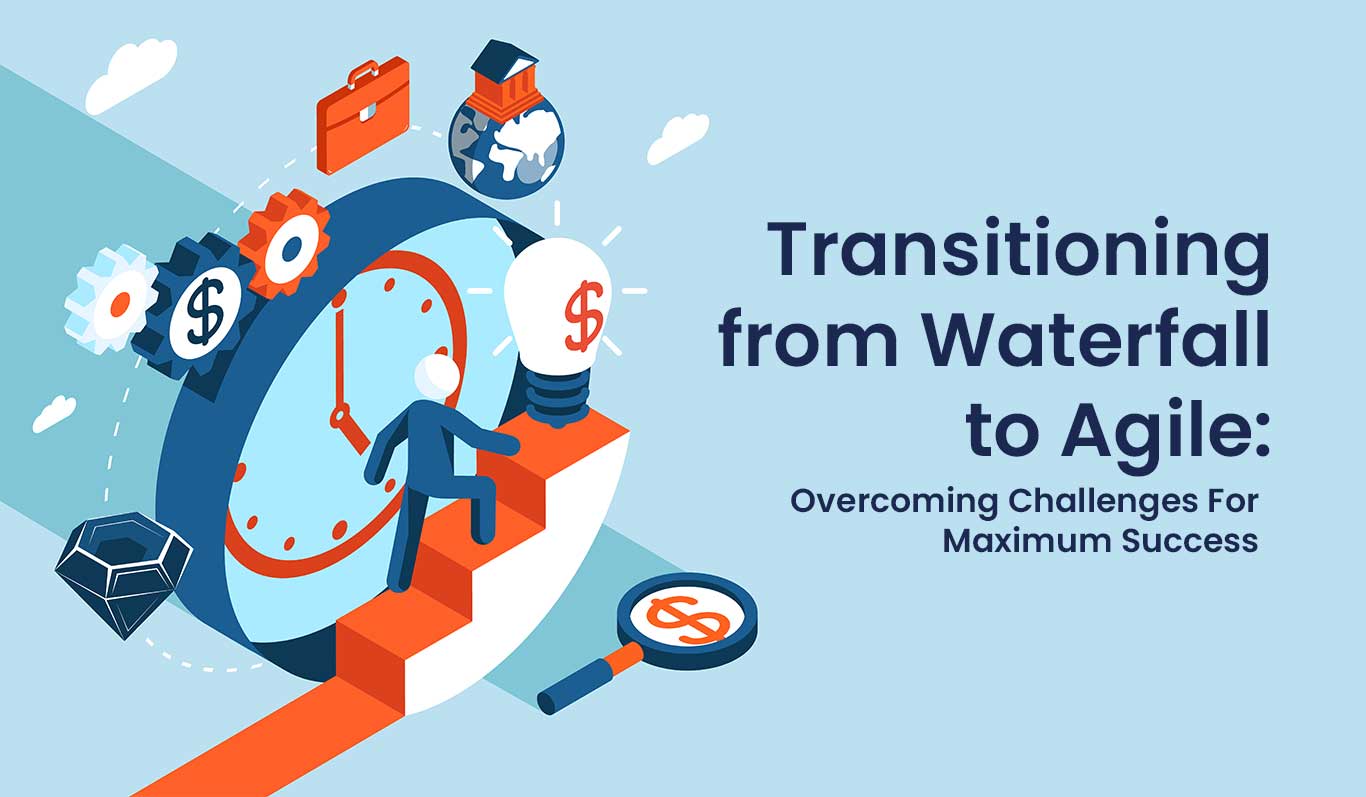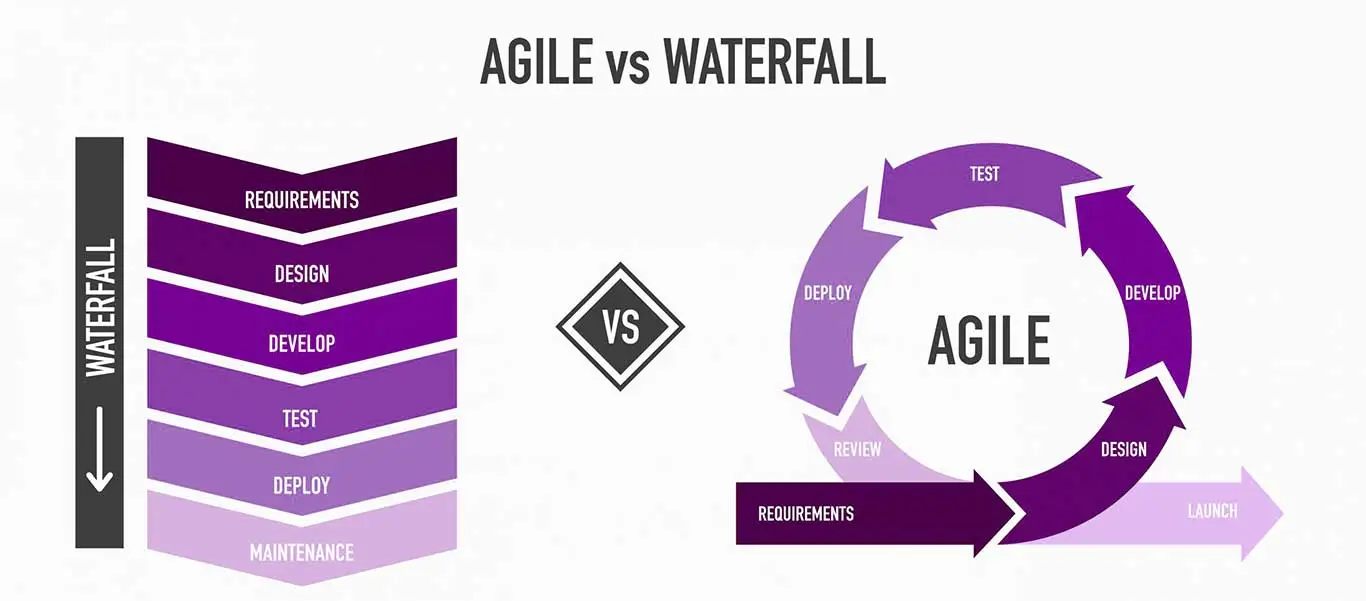Transitioning from Waterfall to Agile: Overcoming Challenges For Maximum Success

Introduction
Have you heard of Waterfall and Agile? They're two different approaches to project management.
Agile is fun, flexible, and collaborative. It's great for smaller projects where you need a minimum viable product (MVP). In contrast, Waterfall is more controlled and stringent, with milestones and goals clearly defined. Just like the gym teacher who makes you run laps before you can play.
But don't get too hung up on the differences. It depends on the project, and what works for one project may not work for another.
Waterfall Methodology
First, let's look at Waterfall.
Waterfall is the traditional way to develop software. In a Waterfall project, each phase should be completed and perfected before moving onto the next.
Just like building a house, you can't paint the walls until the foundation is solid. With this approach, risk gets pushed back into the development process, causing problems later, leading to increased costs or project termination.
Agile Methodology
Let's talk about Agile, the flexible and fun approach. All agile development processes are iterative or cyclic, which means they implement software incrementally.
Different iterative approaches exist today, like Scrum, Kanban, RUP, Extreme Programming, Rapid Application Development, etc.
Teamwork is key to Scrum's agile development model. It's better to build one small piece at a time so you can respond to feedback, change, and build what you need.
Each sprint, work is reviewed and evaluated by the customer. Finished work should be shippable, which means it should work as intended and have been tested. Therefore, Agile relies heavily on customer involvement throughout the project since they have to validate the functionality and approve it.
So, Which One to Choose?
Depending on the project and the team involved, the answer to this question will differ. Depending on the size and the complexity of the project, waterfall may be the best choice, while Agile may be a better option when the project is small and flexible. The important thing to remember is that no matter which approach you choose, what is most important is collaboration, communication, and continuous improvement.
Why Transition from Waterfall to Agile Model?

Traditionally, the Waterfall model is linear and sequential, with each phase completed before moving onto the next. Adapting to changes in the project can be hard with this rigid approach.
Here's where Agile comes in. It's modular and iterative, with work broken down into bite-sized chunks. Because it's flexible and adaptable, it's a popular choice for modern software development teams.
In recent years, Agile has become more popular for several reasons.
1. Rapid technological change. As technology keeps evolving, it can be hard to predict what we'll need next. The iterative approach of Agile helps teams adapt quickly to changes.
2. Modern organizations have changed. Hierarchical structures become less effective as teams become more specialized and interconnected. It's perfect for this new environment since Agile emphasizes collaboration and self-organization.
3. Involvement of customers in development has skyrocketed. Customers want results fast and to have more input into the final product. As a result of Agile's iterative approach, teams can deliver working software quickly and adjust as they go.
Getting Ready for a Waterfall to Agile Project Management Transition
Think about switching from old-school waterfall to new, shiny agile? To make the Agile Transformation journey a little smoother, we've put together a set of key Agile Transformation steps.
Step 1:
In order to use Scrum effectively, we need the right people, processes, support, and tools. The task at hand is to find a qualified Scrum Master, prioritize the product backlog, and figure out how long a sprint should be. It's like packing for a road trip - make sure you have everything!
Step 2:
Once we've figured out our plan, it's time to get everyone on board. Make sure everyone understands and buys into Agile and Scrum. Spend some money on role-based training for your managers and teams. You want everyone to be ready for the transition.
Step 3:
Change is hard, and sometimes we need a little extra support. Coaching helps with that. Agile coaches can help your team change their habits and think differently. Invest in coaching for the Scrum Master, Development Team, and Product Owner.
Step 4:
You can't just transition to Agile once and be done. Incorporating continuous learning and improvement into our approach is key. Similar to upgrading your phone, you don't just do it once and forget about it. To stay ahead, you've got to keep updating and improving.
There you go - the key steps to Agile Transformation! Having the right people in place to guide you through this transition is crucial to its success. It's all about planning, training, coaching, and iteration!
How to Implement Agile Methodology?
Are you ready to grow your business? Now's the time to implement Agile!
Clearly define your goals: Defining your Agile implementation goals is essential before you start. Make sure everyone understands what's going on so you can progress faster.
Create a collaborative environment: The key to Agile success is cross-collaboration. If your team works together seamlessly, you'll get better results. Your team will be more cohesive and trusting.
Transparency and trust are key: It's all about taking risks and trying new things without letting fear hold you back. Create an environment where employees feel comfortable sharing their opinions.
Continual improvement: The agile way of doing things encourages constant improvement. Make sure you're proactive in delivering results to your customers.
Quality over quantity: Agile projects are more about quality than quantity. You need to pay attention to every detail and strive for excellence.
Plan your risk management: Planning for managing risk is essential when implementing Agile. Take care of potential problems before they happen so you're always prepared.
Keep an eye on progress and tweak as needed: Make sure your plans are on track and adjust them as needed. Take regular stock of key performance indicators (KPIs) so you can make informed decisions.
How to Overcome Agile Challenges and Get Everyone on Board?
Agile mindset: Getting people on board
It's more than just stand-ups and Kanban boards, it's a cultural way of working that needs to be ingrained across the organization and in teams. However, getting stakeholders on board with systemic change can be tough. Providing education and training on Agile principles is key to overcoming this challenge. Boost productivity, improve quality, and speed up delivery with open communication and collaboration across teams.
Hybrid/Agile/Waterfall delivery using Agile principles
In a hybrid Agile waterfall delivery, it's hard to apply Agile principles. Clarify gaps by understanding the current delivery landscape and documenting it. Utilizing techniques like MoSCoW with customers can help you make sure pre-determined requirements are delivered in priority order. Ensure stakeholders know about the hybrid delivery approach and the benefits it can bring by communicating with them.
Cost estimates are not available in Agile, so vendors avoid them
A challenge of Agile is that the costs of initiatives are often unknown, and vendors may not give estimates. Yet, organizations still need to figure out how much it will cost to deliver initiatives. An OKR approach provides funding based on predetermined objectives and results. If you set clear goals and metrics for success, you can estimate costs more accurately and make sure budgets are allocated correctly.
Delivering a specific solution in spite of scope changes
It's tough to deliver a specific solution when the scope changes and costs are unknown. Prioritizing requirements and working closely with customers can help you overcome this problem. With MoSCoW, you can categorize requirements into Must-haves, Should-haves, Could-haves, and Won't-haves. Even if the project scope changes, this helps make sure the important stuff gets done first.
Fast-changing processes and systems holding back delivery teams
In Agile, changes happen fast, but processes and systems can slow them down. Many companies don't have visibility into their functions because they run "project tools monopolies." You need a consistent framework and a way to identify process gaps. By doing this, teams will have the tools they need to succeed in Agile ways of working.
Leadership that doesn't get Agile but thinks they do
It can be frustrating working with leaders who don't understand Agile but think they do. Board members and executives need to learn Agile, especially if they're requesting change. We need to upskill the executive team and board and make sure they know what Agile is. Demonstrating the benefits of Agile ways of working in terms of faster delivery, better quality, and increased productivity by using real-world examples is also helpful.
Conclusion
Although implementing Agile ways of working isn't easy, there are ways to overcome them. An organization can successfully implement Agile principles by focusing on communication, collaboration, and establishing a consistent framework and prioritizing requirements. It's hard to switch from waterfall to agile, but the rewards are awesome. Agile teams can respond quickly to change, deliver value faster, and continuously improve. Agile, however, isn't one-size-fits-all. It may be best to combine methodologies or use a hybrid approach depending on the project. At the end of the day, it's about following a process consistently. It's all about committing to a process and continuously improving it, no matter what you choose.
Request a Quote
Categories
Popular posts
Best Practices for Software Product Engineering Every CTO Should Implement
2023-14-18How to Build Your Own On-Demand Carpooling App Services?
2023-08-25How to Start an On-Demand Fuel Delivery Business: A Comprehensive Guide
2023-07-28Empowering Miners: How Fleet Management Apps are Transforming the Mining Industry?
2023-07-21A Complete Guide to Develop a Food Delivery App for Restaurants in 2023
2023-07-08Mobile Apps Transforming the Travel Industry: A Game-Changer in Travel Planning and Experience
2023-07-07
